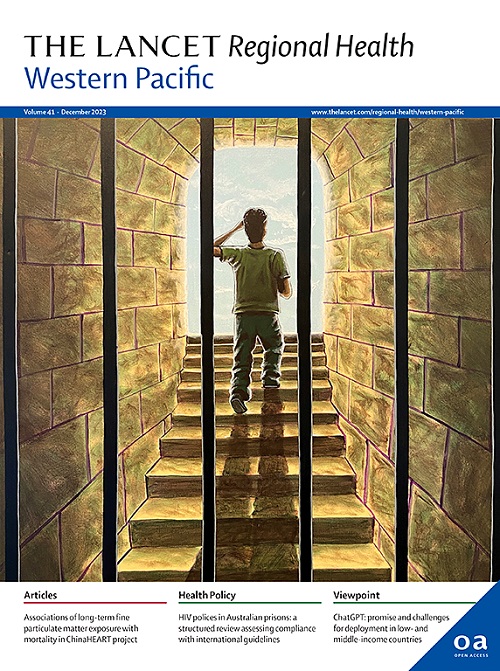Persistent lymphatic filariasis transmission seven years after validation of elimination as a public health problem: a cross-sectional study in Tonga
IF 7.6
1区 医学
Q1 HEALTH CARE SCIENCES & SERVICES
引用次数: 0
Abstract
Background
The World Health Organization (WHO) has validated 21 countries as having eliminated lymphatic filariasis (LF) as a public health problem. Post-validation surveillance (PVS) is required in countries where LF has been eliminated. Tonga eliminated LF in 2017, but no PVS strategy has been established. We aimed to identify any persistent LF transmission in Tonga in 2024 and provide evidence to support a PVS strategy.
Methods
A four-pronged, targeted, cross-sectional study was conducted in the Tongan districts of Tongatapu, Ha’apai, and Ongo Niuas in May–July 2024 in communities, primary schools, high schools, and an outpatient clinic. Participants were tested for LF antigen (Ag) and microfilariae (Mf). The outcome measure for persistent LF transmission was Ag-positivity.
Findings
Between 9 May and 19 July 2024, 1787 participants were recruited from 12 communities, 11 primary schools, five high schools, and one outpatient clinic. Overall, 39 participants (2·2%) were Ag-positive and five (0·3%) were Mf-positive. The highest Ag prevalence was in communities (4·0%; 95% confidence interval [95%CI]: 2·9–5·6), where all Mf-positives (n = 5) were identified. Ag-positivity was associated with male sex (adjusted odds ratio [aOR]:4·86; 95%CI: 2·25–10·46), older age (>50 years vs 5–10 years [aOR:7·51; 95%CI: 2·13–26·47]), and residing in Ha’apai (aOR:15·08; 95%CI: 5·41–42·05) and Ongo Niuas (aOR:10·85; 95%CI: 3·91–30·08).
Interpretation
We found persistent LF transmission in Tonga seven years post-validation. Community surveillance yielded the highest Ag and Mf prevalence. Efficiency of PVS could be improved by integrating surveillance activities into the existing health system and conducting community-based surveys, particularly among older males and in high prevalence areas.
Funding
Task Force for Global Health, Bill & Melinda Gates Foundation, and the United States Agency for International Development.
确认作为公共卫生问题消除淋巴丝虫病7年后仍在传播:汤加的横断面研究
世界卫生组织(世卫组织)已确认21个国家已将淋巴丝虫病作为一个公共卫生问题消除。在已消除LF的国家,需要进行验证后监测。汤加在2017年消灭了LF,但没有建立PVS战略。我们的目标是确定2024年汤加的任何持续性LF传播,并为支持PVS战略提供证据。方法于2024年5 - 7月在汤加塔普、哈派和翁戈牛亚斯的汤安区社区、小学、高中和门诊进行四方面、有针对性的横断面研究。检测参与者的LF抗原(Ag)和微丝蚴(Mf)。持续性LF传播的结局指标为ag阳性。在2024年5月9日至7月19日期间,从12个社区、11所小学、5所高中和一家门诊诊所招募了1787名参与者。总体而言,39名参与者(2.2%)为ag阳性,5名参与者(0.3%)为mf阳性。银患病率最高的是社区(4.0%;95%置信区间[95% ci]: 2.9 - 5.6),其中所有mf阳性(n = 5)被确定。ag阳性与男性相关(校正优势比[aOR]: 4.86;95%CI: 2.25 - 10.46),老年(50岁vs 5-10岁)[aOR: 7.51;95%CI: 2.13 ~ 26.47]),居住在哈派(aOR: 15.08;95%CI: 5.41 ~ 42.05)和Ongo niwas (aOR: 10.85;95%置信区间:3 * 91 - 30 * 08年)。我们在确认后7年在汤加发现了持续的LF传播。社区监测结果显示银屑病和Mf患病率最高。通过将监测活动纳入现有卫生系统并开展社区调查,特别是在老年男性和高流行地区进行调查,可以提高艾滋病毒/艾滋病监测的效率。全球卫生筹资工作队,比尔和安培;梅琳达·盖茨基金会和美国国际开发署。
本文章由计算机程序翻译,如有差异,请以英文原文为准。
求助全文
约1分钟内获得全文
求助全文
来源期刊

The Lancet Regional Health: Western Pacific
Medicine-Pediatrics, Perinatology and Child Health
CiteScore
8.80
自引率
2.80%
发文量
305
审稿时长
11 weeks
期刊介绍:
The Lancet Regional Health – Western Pacific, a gold open access journal, is an integral part of The Lancet's global initiative advocating for healthcare quality and access worldwide. It aims to advance clinical practice and health policy in the Western Pacific region, contributing to enhanced health outcomes. The journal publishes high-quality original research shedding light on clinical practice and health policy in the region. It also includes reviews, commentaries, and opinion pieces covering diverse regional health topics, such as infectious diseases, non-communicable diseases, child and adolescent health, maternal and reproductive health, aging health, mental health, the health workforce and systems, and health policy.
 求助内容:
求助内容: 应助结果提醒方式:
应助结果提醒方式:


